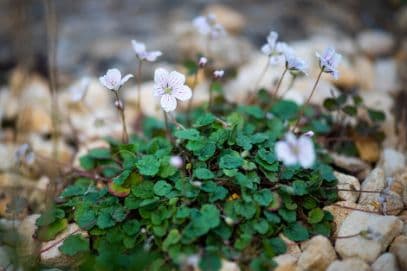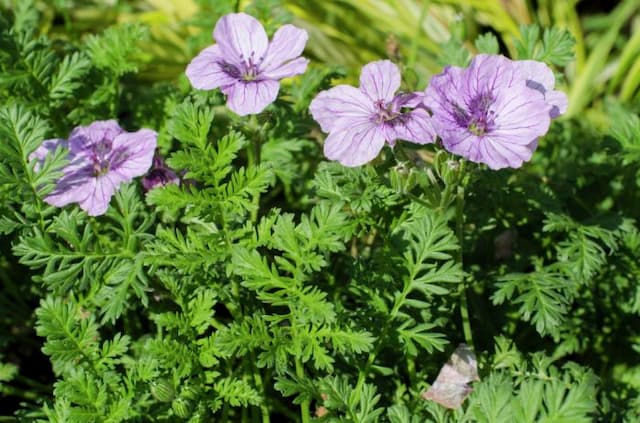Scented Geranium Pelargonium 'Brackenwood' (Dw/d)

ABOUT
Pelargonium 'Brackenwood' is a type of geranium that is recognized for its vibrant and colorful appearance. This plant features an abundance of lush, green foliage that forms a dense and attractive backdrop for the flowers. The leaves are typically rounded, with a soft, velvety texture and may exhibit a zonal pattern which can be a darker green hue. The geranium is most admired for its striking flowers that can be seen blooming in clusters. These blooms are characterized by their vivid colors which can range from bright pinks to deep reds, oftentimes with attractive veining or eye-catching patterns on the petals. Each flower has a classic geranium form, consisting of five petals, with the upper two usually being a different shade or marked with distinctive spots. Flowering tends to be prolific under the right conditions, with the plant being capable of producing numerous blossoms that provide a showy display. The stems carrying the flowers typically emerge prominently from the plant's foliage, giving the blooms a noticeable prominence. Overall, the geranium 'Brackenwood' is known for its ornamental qualities, with its colorful and abundant flowers providing a welcoming attraction in any garden setting where it is planted.
About this plant
 Names
NamesFamily
Geraniaceae.
Synonyms
No common names available.
Common names
Pelargonium 'Brackenwood' (Dw/d).
 Toxicity
ToxicityTo humans
Geraniums like the Pelargonium 'Brackenwood' are generally considered non-toxic to humans. They are not known to contain any significant amounts of compounds that are harmful when ingested. Therefore, eating parts of this plant typically does not lead to any serious health consequences. However, as with any non-food plants, ingesting large quantities or having a personal sensitivity could potentially result in minor gastrointestinal upset or allergic reactions.
To pets
Geraniums, such as the Pelargonium 'Brackenwood', can be toxic to pets, particularly to cats and dogs. If ingested, the plant can cause symptoms such as vomiting, diarrhea, depression, anorexia, and dermatitis. The essential oils and other compounds contained within the plant can lead to these adverse reactions. While it is typically not life-threatening, it is advisable to keep this plant out of reach of pets to prevent potential toxicity. If a pet does ingest some of the plant and displays these symptoms, consult with a veterinarian.
 Characteristics
CharacteristicsLife cycle
Perennials
Foliage type
Semi-deciduous
Color of leaves
Green
Flower color
Mixed
Height
1-2 feet (30-61 cm)
Spread
1-2 feet (30-61 cm)
Plant type
Herb
Hardiness zones
9
Native area
South Africa
Benefits
 General Benefits
General Benefits- Ornamental Appeal: Adds aesthetic value to gardens with its vibrant flowers and attractive foliage.
- Low Maintenance: Requires minimal care, making it suitable for gardeners of all skill levels.
- Drought Tolerance: Can survive with limited water, ideal for xeriscaping or regions with water scarcity.
- Adaptability: Thrives in a range of climatic conditions and soil types.
- Long Blooming Period: Offers colorful blooms for a significant portion of the year.
- Attracts Pollinators: Flowers are known to attract bees, butterflies, and other beneficial insects.
- Compact Growth: Suitable for container gardening or small spaces due to its dwarf/dense form.
 Medical Properties
Medical PropertiesThis plant is not used for medical purposes.
 Air-purifying Qualities
Air-purifying QualitiesThis plant is not specifically known for air purifying qualities.
 Other Uses
Other Uses- As a natural dye: The vibrant leaves and flowers of geranium can be used to create natural dyes for fabric, offering a range of colors from green to pink, depending on the part of the plant used.
- Insect repellent sachets: Dried geranium leaves, when placed in sachets, can help repel insects from clothing and linen closets with their strong fragrance.
- Companion planting: Geraniums are often used in gardens as companion plants to deter pests from vegetables and other flowers, as their scent confuses insects.
- Eco-friendly confetti: Dried geranium petals can serve as a biodegradable alternative to traditional paper confetti at celebrations, reducing environmental impact.
- Flavoring for beverages: Leaves from the geranium plant can be infused in water or teas to impart a subtle rose-like flavor.
- Aromatherapy: The essential oils extracted from geranium can be used in aromatherapy for their calming and uplifting properties.
- Photography props: The attractive flowers and foliage of geraniums can be used as props in photography, adding natural beauty to the composition of still-life or product photographs.
- Decorative food garnishes: Edible varieties of geranium petals can add aesthetic value and a touch of flavor when used as garnishes on desserts and salads.
- Craft projects: Pressed geranium flowers and leaves can be used to create artistic craft projects, such as bookmarks and greeting cards.
- Homemade potpourri: Dried geranium leaves and flowers can be mixed with other botanicals to create aromatic potpourri for freshening up living spaces.
Interesting Facts
 Feng Shui
Feng ShuiThe Geranium is not used in Feng Shui practice.
 Zodiac Sign Compitability
Zodiac Sign CompitabilityThe Geranium is not used in astrology practice.
 Plant Symbolism
Plant Symbolism- Positive Emotions: Pelargoniums, also known as geraniums, often symbolize happiness and positive emotions. The 'Brackenwood' variety's vibrant blooms can lift spirits and signify joy.
- Comfort: The geranium's homely and familiar presence in many gardens can represent comfort and a sense of belonging or domestic tranquility.
- Friendship: Geraniums are sometimes given as gifts to express a desire for enduring friendship or to strengthen the social bond between individuals.
- Health: The geranium plant is often associated with good health and recovery from illness, due in part to their use in traditional medicine as well as their fresh, clean scent.
 Water
WaterGeraniums like 'Brackenwood' should be watered thoroughly when the top inch of soil feels dry to the touch. Typically, this will mean watering approximately once a week, but this can vary depending on environmental conditions. When watering, avoid getting water on the foliage, and instead water directly at the base of the plant to minimize the risk of leaf diseases. During the active growing season in the spring and summer, an average-sized geranium might require around 16 ounces of water per week, but always adjust based on the plant's appearance and soil moisture level.
 Light
LightGeraniums, including the 'Brackenwood' variety, thrive best in bright, indirect sunlight. A spot that gets at least 4 to 6 hours of sunlight per day, like an east or west-facing windowsill, is ideal for these plants. Direct afternoon sun, especially in hotter climates, can be too intense and may cause the foliage to wilt or burn.
 Temperature
TemperatureGeraniums prefer temperatures between 65 to 75 degrees Fahrenheit during the day and should not be exposed to temperatures below 50 degrees Fahrenheit, as they are not frost-tolerant. The 'Brackenwood' geranium can generally tolerate minor fluctuations outside this range, but prolonged exposure to cold can damage or kill the plant.
 Pruning
PruningPruning geraniums like 'Brackenwood' is vital for encouraging bushy growth and preventing legginess. They should be pruned in early spring before the growing season starts or any time you notice the plant becoming too large or unruly. Remove dead or yellow leaves and spent flowers regularly to promote new growth and improve airflow.
 Cleaning
CleaningAs needed
 Soil
SoilGeranium 'Brackenwood' prefers well-draining soil with a mix of potting soil, peat, and perlite or sand. The ideal soil pH range is between 6.0 and 7.0 for optimal growth.
 Repotting
RepottingGeranium 'Brackenwood' should be repotted every one to two years to replenish the soil and give roots space to grow. Early spring is the best time for repotting.
 Humidity & Misting
Humidity & MistingGeranium 'Brackenwood' fares best in average room humidity levels, avoiding excessively high humidity which can lead to issues with fungal diseases.
 Suitable locations
Suitable locationsIndoor
Provide bright, indirect light and avoid overwatering.
Outdoor
Plant in sunny spot, protect from frost, and allow soil to dry.
Hardiness zone
10-11 USDA.
 Life cycle
Life cycleThe Pelargonium 'Brackenwood (Dw/d)' begins its life cycle as a seed, which when sown, germinates in warm conditions with ample moisture. Upon sprouting, the seedling emerges and starts developing true leaves, entering the vegetative stage where it focuses on leaf and stem growth. As it matures, the plant enters the flowering stage, producing vibrant flowers that attract pollinators for sexual reproduction; if pollinated, the flowers will form seeds. After pollination and seed set, the parent plant can enter a period of reduced activity or semi-dormancy, particularly in cooler or less favorable conditions. When conditions are right, it resumes vigorous growth, which may include producing offsets or new shoots that can be propagated to create new plants. Eventually, after several years and depending on growing conditions, the plant may begin to decline, completing its life cycle, but it may live for many years with proper care.
 Propogation
PropogationPropogation time
Spring-Early Summer
The Pelargonium 'Brackenwood', commonly known as geranium, is typically propagated through stem cuttings. This method is most effectively carried out during the active growing season, which is usually spring through early summer. A healthy stem cutting of about 4 to 6 inches (10 to 15 centimeters) is taken, making sure there are at least two sets of leaves. The lower leaves are removed, and the cut end may be dipped in rooting hormone powder to encourage root development. The cutting is then placed in a pot filled with moistened, well-drained potting mix, with about half of the cutting's length buried in the soil. The pot is kept in a warm, brightly lit location, but out of direct sunlight, and the soil is kept consistently moist but not soggy until roots have established, typically within a few weeks.




![Cranesbill [Blue Sunrise]](/_next/image?url=https%3A%2F%2Fplants-admin.emdemapps.com%2Fimages%2Fplants%2F%2Fimages%2F604b638d45948.png&w=640&q=75)




